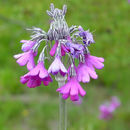Description
provided by eFloras
Herbs perennial. Leaves forming a rosette; petiole short or occasionally ca. as long as leaf blade, broadly winged; leaf blade oblong to narrowly elliptic or oblanceolate, 5--15 X 1--3 cm, tapering toward base, sparsely minutely glandular, margin hydathode-denticulate, apex subrounded to acute. Scapes 10--60(--90) cm, white farinose toward apex; umbels 1, or occasionally 2, superimposed, 5--10-flowered; bracts 5--10 mm. Pedicel nodding at anthesis, 1--5 cm, ± farinose. Flowers secund, heterostylous. Calyx tinged with purple from lobes to base, tubular-campanulate, 7--10 mm, upper 1/2 parted, white farinose between lobes forming 5 purple and 5 white vertical stripes; lobes lanceolate to triangular-lanceolate. Corolla rose-purple to deep rose; limb 1.5--2.5 cm wide; lobes obovate-oblong, apex rounded to slightly emarginate. Pin flowers: corolla tube 9--10 mm; stamens slightly below middle of corolla tube; style ca. as long as tube. Thrum flowers: corolla tube 1--1.3 cm; stamens toward apex of corolla tube; style 2--3 mm. Capsule elliptic, ca. 1.5 X as long as calyx. Fl. Jun-Jul, fr. Aug-Sep. 2n = 22@.
- license
- cc-by-nc-sa-3.0
- copyright
- Missouri Botanical Garden, 4344 Shaw Boulevard, St. Louis, MO, 63110 USA
Distribution
provided by eFloras
E Qinghai, W Sichuan, E Xizang, NW Yunnan
- license
- cc-by-nc-sa-3.0
- copyright
- Missouri Botanical Garden, 4344 Shaw Boulevard, St. Louis, MO, 63110 USA
Habitat
provided by eFloras
* Ditches, wet meadows, bog margins; 3200--4800 m.
- license
- cc-by-nc-sa-3.0
- copyright
- Missouri Botanical Garden, 4344 Shaw Boulevard, St. Louis, MO, 63110 USA
Synonym
provided by eFloras
Primula vittata Bureau & Franchet.
- license
- cc-by-nc-sa-3.0
- copyright
- Missouri Botanical Garden, 4344 Shaw Boulevard, St. Louis, MO, 63110 USA
Cyclicity
provided by Plants of Tibet
Flowering from June to July; fruiting from August to September.
Distribution
provided by Plants of Tibet
Primula secundiflora is occurring in E Qinghai, W Sichuan, E Xizang, NW Yunnan of China.
Evolution
provided by Plants of Tibet
Phylogeography of Primula secundiflora were inferred from the sequence variation of the chloroplast trnL-trnF and rps16 (Wang et al., 2008). Results shown that the total diversity (HT=0.966) is high while the within-population diversity (HS=0.178) is low. Despite the high uniformity of the intraspecific morphology, an analysis of molecular variance (AMOVA) revealed a high level of genetic differentiation (97.65%) among populations. Phylogenetic analyses of haplotypes identified four major clusters of the recovered haplotypes: three clades in the north, and the other one in the south. The isolated distribution of clades suggested multiple refugia of this species during the glacial stages. The low intra-population diversity suggested that most of the populations should have experienced the in situ shrink-expansion cycles during the climatic oscillations. This inference was further supported by the nested clade analysis, which indicated that restricted gene flow with isolation by distance and allopatric fragmentation were likely the major processes that shaped the present-day spatial distribution of haplotypes in this species. Such a special phylogeographic pattern may have resulted from a combination of both climatic oscillation and complex topology of the Hengduan Mountains.
General Description
provided by Plants of Tibet
Herbs perennial. Leaves forming a rosette; petiole short or occasionally ca. as long as leaf blade, broadly winged; leaf blade oblong to narrowly elliptic or oblong-lanceolate, 5-15 cm long, 1-3 cm wide, tapering toward base, sparsely minutely glandular, margin hydathode-denticulate, apex subrounded to acute. Scapes 10-70 cm, white farinose toward apex; umbels 1, or occasionally 2, superimposed, 5-10-flowered; bracts 5-10 mm. Pedicel nodding at anthesis, 1-5 cm, ± farinose. Flowers secund, heterostylous. Calyx tinged with purple from lobes to base, tubular-campanulate, 7-10 mm, upper 1/2 parted, white farinose between lobes forming 5 purple and 5 white vertical stripes; lobes lanceolate to triangular-lanceolate. Corolla rose-purple to deep rose; limb 1.5-2.5 cm wide; lobes obovate-oblong, apex rounded to slightly emarginate. Pin flowers: corolla tube 9-10 mm; stamens slightly below middle of corolla tube; style ca. as long as tube. Thrum flowers: corolla tube 1-1.3 cm; stamens toward apex of corolla tube; style 2-3 mm. Capsule elliptic, ca. 1.5 times as long as calyx.
Genetics
provided by Plants of Tibet
The chromosomal number of Primula secundiflora is 2n = 22 (Nakata et al., 1997).
Habitat
provided by Plants of Tibet
Growing in ditches, wet meadows, bog margins; 3200-4800 m.
Primula secundiflora
provided by wikipedia EN
Primula secundiflora (偏花报春 pian hua bao chun),[1] the second-flowered primrose, is a species of flowering plant in the family Primulaceae, native to western China (E Qinghai, W Sichuan, E Xizang, NW Yunnan).[1], where it inhabits wet places at 3,200–4,800 m (10,500–15,700 ft). It belongs to the Candelabra group of primulas (sect. Proliferae). Growing to 80 cm (31 in) tall, it is a semi-evergreen perennial bearing clusters of nodding deep red flowers at the top of erect stems.[2]
This plant is sometimes cultivated. It prefers neutral or acid soil, and is especially suitable for moist places such as the banks of streams or ponds, in partial shade.[2]
References

- license
- cc-by-sa-3.0
- copyright
- Wikipedia authors and editors
Primula secundiflora: Brief Summary
provided by wikipedia EN
Primula secundiflora (偏花报春 pian hua bao chun), the second-flowered primrose, is a species of flowering plant in the family Primulaceae, native to western China (E Qinghai, W Sichuan, E Xizang, NW Yunnan)., where it inhabits wet places at 3,200–4,800 m (10,500–15,700 ft). It belongs to the Candelabra group of primulas (sect. Proliferae). Growing to 80 cm (31 in) tall, it is a semi-evergreen perennial bearing clusters of nodding deep red flowers at the top of erect stems.
This plant is sometimes cultivated. It prefers neutral or acid soil, and is especially suitable for moist places such as the banks of streams or ponds, in partial shade.
- license
- cc-by-sa-3.0
- copyright
- Wikipedia authors and editors

